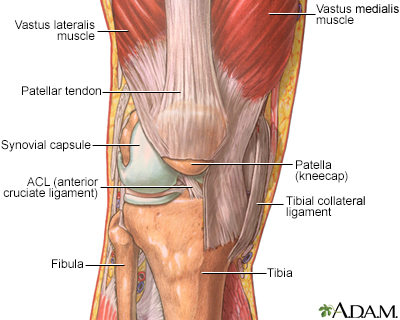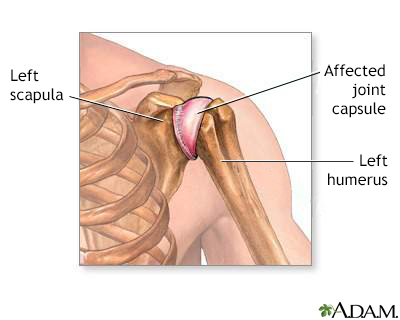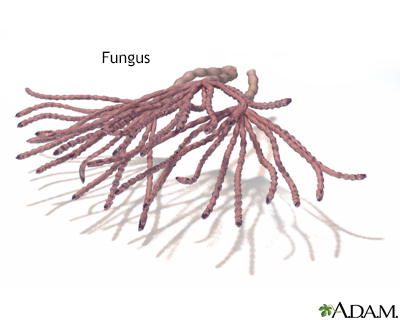Fungal arthritis
Definition
Fungal arthritis is swelling and irritation (inflammation) of a joint by a fungal infection. It is also called mycotic arthritis.
Alternative Names
Mycotic arthritis; Infectious arthritis - fungal
Causes
Fungal arthritis is a rare condition. It can be caused by any of the invasive types of fungi. The infection can result from an infection in another organ, such as the lungs and travel to a joint through the bloodstream. A joint can also become infected during a surgery. People with weakened immune systems who travel or live in areas where the fungi are common, are more susceptible to most causes of fungal arthritis.
Conditions that can cause fungal arthritis include:
- Blastomycosis
- Candidiasis
- Coccidioidomycosis
- Cryptococcosis
- Histoplasmosis
- Sporotrichosis
- Exserohilum rostratum (from injection with contaminated steroid vials)
Symptoms
The fungus can affect bone or joint tissue. One or more joints can be affected, most often the large, weight-bearing joints, such as the knees.
Symptoms may include any of the following:
Exams and Tests
Your health care provider will examine you.
Tests that may be ordered include:
- Removal of joint fluid to look for fungus under a microscope
- Culture of joint fluid to look for fungus
- Joint x-ray showing joint changes
- Positive antibody test (serology) for fungal disease
- Synovial biopsy showing fungus
Treatment
The goal of treatment is to cure the infection using antifungal drugs. Commonly used antifungal drugs are amphotericin B or drugs in the azole family (fluconazole, ketoconazole, or itraconazole).
Chronic or advanced bone or joint infection may require surgery (debridement) to remove the infected tissue.
Outlook (Prognosis)
How well you do depends on the underlying cause of the infection and your overall health. A weakened immune system, cancer, and certain medicines can affect the outcome.
Possible Complications
Joint damage may occur and the risk of damage is higher if the infection is not treated right away.
When to Contact a Medical Professional
Contact your provider for an appointment if you have any symptoms of fungal arthritis.
Prevention
Thorough treatment of fungal infections elsewhere in the body may help prevent fungal arthritis.
Gallery



References
Ohl CA. Infectious arthritis of native joints. In: Bennett JE, Dolin R, Blaser MJ, eds. Mandell, Douglas, and Bennett's Principles and Practice of Infectious Diseases. 9th ed. Philadelphia, PA: Elsevier; 2020:chap 103.
Ruderman EM, Flaherty JP. Fungal infections of bones and joints. In: Firestein GS, Budd RC, Gabriel SE, Koretzky GA, McInnes IB, O'Dell JR, eds. Firestein and Kelley's Textbook of Rheumatology. 11th ed. Philadelphia, PA: Elsevier; 2021:chap 119.